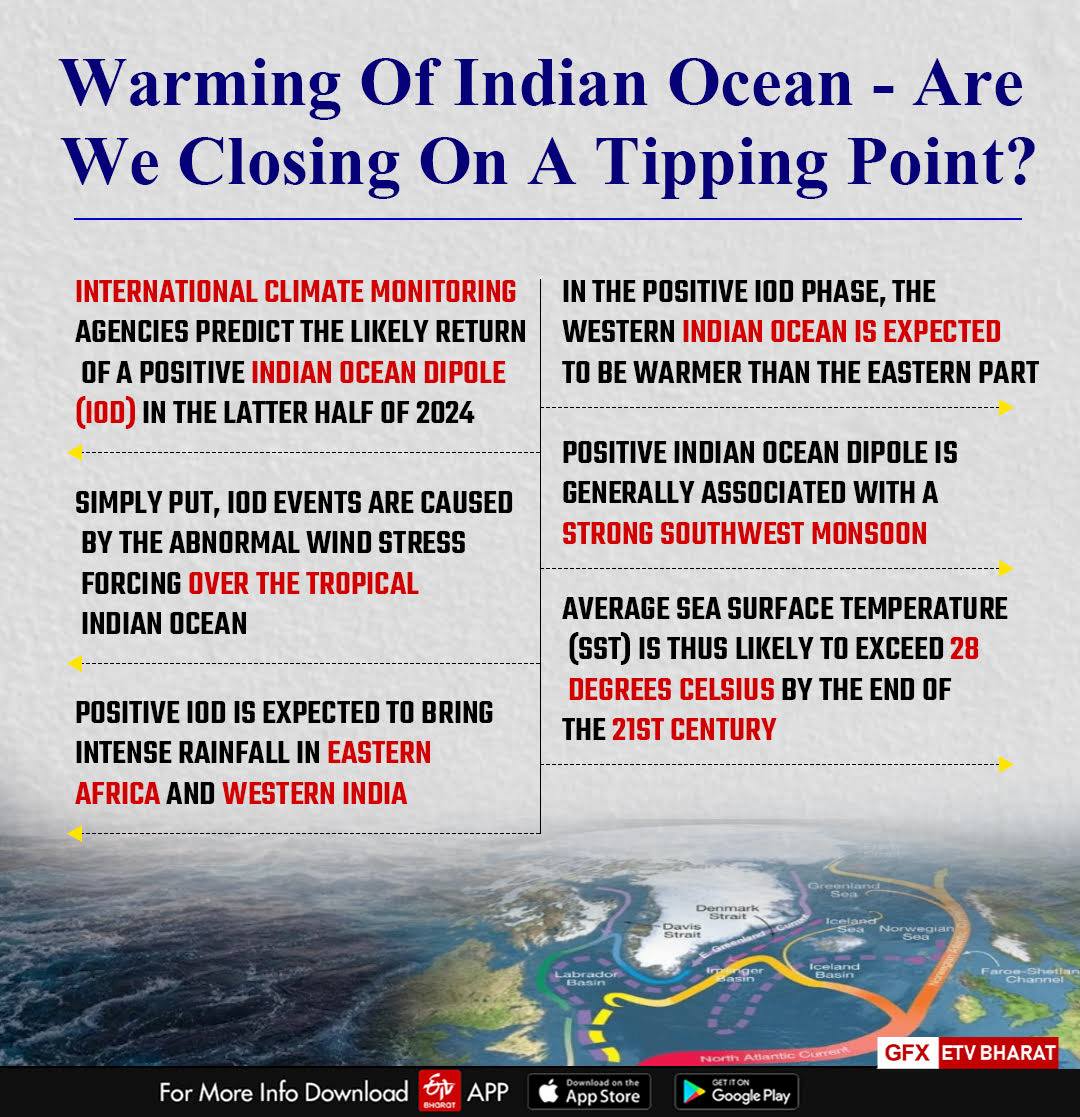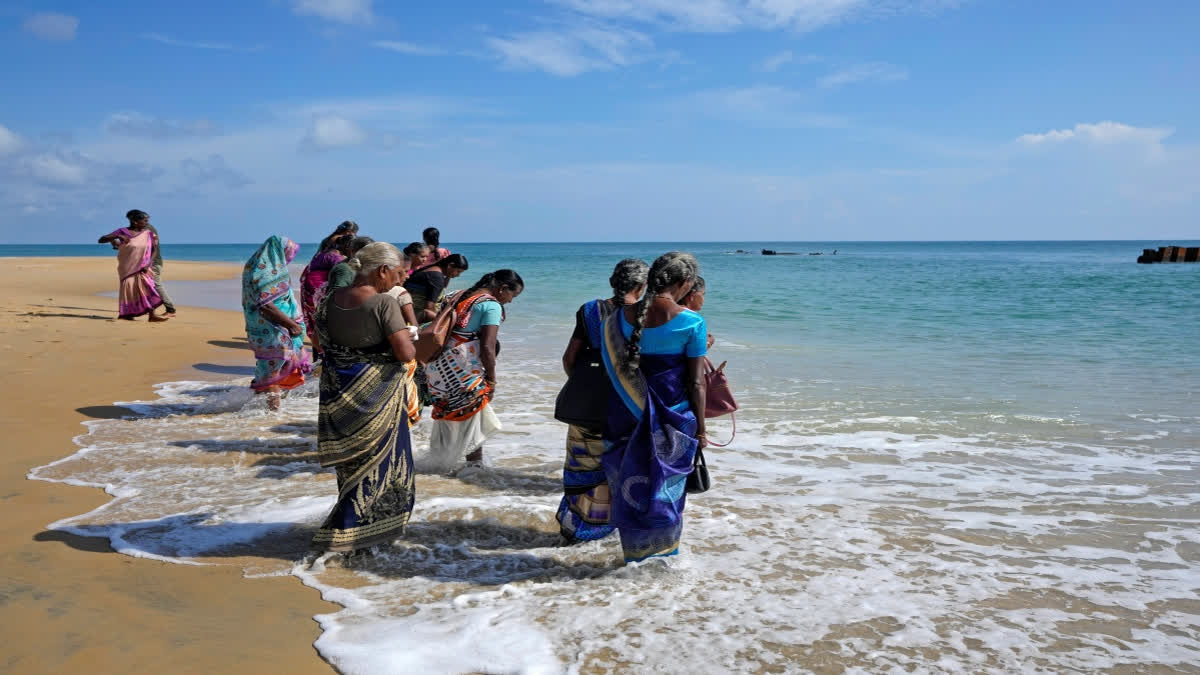International climate monitoring agencies predict the likely return of a positive Indian Ocean Dipole (IOD) in the latter half of 2024. In the positive IOD phase, the western Indian Ocean is expected to be warmer than the eastern part.
The Indian Ocean Dipole (IOD), is a repeatable climate pattern that causes the sea surface temperatures in the western and eastern Indian Ocean to shift back and forth. During the positive phase, the Western Indian Ocean becomes warmer than the Eastern Indian Ocean, and when the pattern reverses, it is called a negative phase.
Published in one of the issues of the journal Nature, back in 1999, a group of Indian researchers led by N.H. Saji first reported this differential behaviour of the Indian Ocean. This phenomenon is comparable to ENSO, or El Niño-Southern Oscillation, a recurring climate pattern that affects the central and eastern tropical Pacific Ocean. As we see in the case of the Indian Ocean during the IOD phases, ENSO is characterised by alternate shifts in ocean surface temperature and air pressure every two to seven years. These shifts have global ramifications in that they disrupt the rainfall and wind patterns across the tropics.
Many theories have been proposed to explain the generation of IOD. While some researchers think the air-sea interactions confined to the Indian Ocean are the primary reason, others assert that the controlling factors are connected to the ENSO oscillations in the western Pacific Ocean.
The question of whether the IOD is an event independent or if it is only a subevent of ENSO is more or less answered. Both modes with different temporal variabilities influence the IOD events, but have similar spatial patterns. In both cases, IODs originate from air-sea interactions – the ENSO mode occurs on the spatial scale of the tropical Pacific Ocean and the other mode is linked to the perturbations associated with the high-pressure area near the Mascarene Islands in the Southern Indian Ocean.
Simply put, the IOD events are caused by the abnormal wind stress forcing over the tropical Indian Ocean, which results in vertical transports, leading to the upwelling and pileup of seawater. When the anomalous easterly exists over the equatorial Indian Ocean, the cold waters up well in the tropical eastern Indian Ocean while the warm waters pile up in the tropical western Indian Ocean.
The positive Indian Ocean Dipole is generally associated with a strong Southwest Monsoon because the air becomes more buoyant over the warm water, triggering evaporation and the formation of water-saturated clouds. The positive IOD is expected to bring intense rainfall in eastern Africa and western India in contrast to drier conditions in Eastern Asia and Australia. With the formation of positive IOD, factors including human-caused global warming also need to be factored in with naturally occurring weather and climate cycles.
Because of the global warming, the frequency of positive IOD events may increase. A 2014 study published in Nature, conducted by scientists from Australia, India, China and Japan modelled the effects of CO2 on extreme Indian Ocean dipoles, such as those in 1961, 1994 and 1997.
Assuming an increase in greenhouse gas emissions, their model predicted that the frequency of extreme positive dipole events would increase this century from one every 17.3 years to one every 6.3 years. In a recently published article (titled, 'Future Projections for the tropical Indian Ocean' in a compilation published by Elsevier), scientists led by Roxy Mathew Koll from the Institute of Tropical Meteorology presented an alarming scenario that the Indian Ocean could warm, ranging from 1.7 to 3.8 degrees Celsius in the longer term.

The average sea surface temperature (SST) is thus likely to exceed 28 degrees Celsius by the end of the 21st century. Scientists warn that this can potentially bring disproportionately frequent and temporally intense rainfall, droughts, tropical cyclones and forest fires in the region with geographically varying impacts.
These changes will impact the Southwest Monsoon, which makes up 70 per cent of India's annual rainfall. In the same study, it is predicted that the end of this century will also see the surface pH falling below 7.7 from the previously recorded pH above 8.1. The resultant acidification of seawater will further degrade the marine ecosystem and productivity. Acidification will be a major threat to coral reefs, most abundant around the Lakshadweep and Maldives in the Arabian Sea and the Andaman-Nicobar and Sumatra in the Bay of Bengal.
Mongabay reported on research conducted by the Institute of Tropical Meteorology, which found an average increase of sea surface temperature by 0.15 degrees Celsius per decade between 1951 and 2015. It is also revealed that the western Indian Ocean experienced about 66 marine heat waves between 1982 and 2018. Quoting the statement made in Rajya Sabha in 2022 by the then Minister of State for Earth Science, Mongabay reports that the north Bay of Bengal experienced a two-to-three-fold rise in heat waves.
The thermal expansion of seawater could lead to sea level rise, complementing the impacts of glacial melt at the poles. Thermal expansion accounted for almost 50 per cent of the sea level rise. Sea level rise is not globally uniform and varies regionally, and India and Bangladesh will be the worst affected, according to the World Meteorological Organisation.
It is predicted that about 25 per cent of mangroves at a global level could be submerged over the next 50 years, if the current warming trends continue. Besides its negative impact on carbon sequestration, the loss of mangroves could expose millions of people to coastal flooding across the globe.
Sea level rise in the southwestern Indian Ocean occurs at a rate of 2.5 mm/year - faster than the global average and in other parts of the Indian Ocean region. As reported by the National Centre for Coastal Research, the states of West Bengal (Sundarbans), Odisha, Pondicherry, Tamil Nadu and Kerala are already under the grip of coastal erosion triggered by sea level rise.
Many areas of central Kerala including parts of Kuttanad, Kochi (Vypin), Vaikom and Thrissur are flagged as high-risk zones of sea level rise. Local tidal variations, man-made morphological changes, and environmental degradation augment the average sea-level rise. The Indian cities of Kolkata, Chennai and Mumbai are also under threat of sea level erosion. A paper published in the Geophysical Research Letters of March 2022 suggests that Mumbai is grappling with a double whammy of land subsidence at the rate of 2 mm/year due to heavy groundwater pumping combined with the load of massive construction and the rising sea.
The projections show that by the year 2050 millions of people living in the Indian Ocean rim countries will be impacted by increased frequency of coastal floods. It is time to think about adaptive measures like the construction of dams and dikes to minimise the impact of coastal erosion.
As the Dutch would say "meebewegen", roughly translated as "moving with water", it is also worthwhile to consider long-term strategies to cope with the sea-level rise like elevated or floating housing and salt-tolerating agriculture. As a country with one-third of its land lying below the sea level and is likely to be worst affected by the projected sea-level rise, the Netherlands has shown the world that there is a way to work with the water instead of against it.



